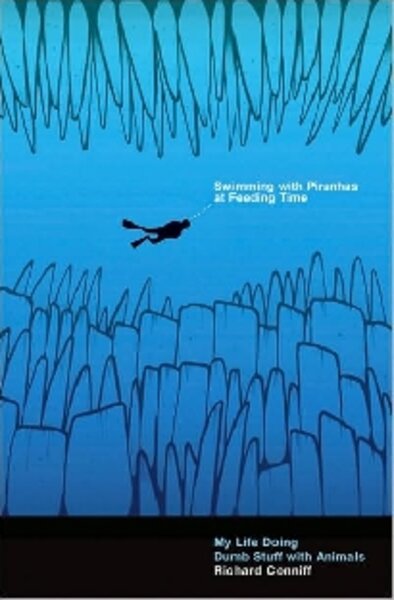Swimming with Piranhas at Feeding Time
Loading...
There’s dumb, and then there’s dumber. Swimming with a school of man-eating fish makes the cut, as does letting a pack of African wild dogs sniff your neck. Natural history writer Richard Conniff has been there, done that, and lived to tell the tales.
(Hummingbirds, it turns out, are more aggressive than either wild dogs or pirahnas.)
The author of Swimming with Piranhas at Feeding Time is a regular contributor to National Geographic and Smithsonian and is a frequent contributor to NPR. Conniff’s eighth book tells of his forays into Amazon rainforests and African savannas.
Conniff has run with cheetahs, hung with leopards, and even confronted feral thrips and springtails in an inner-city Connecticut park, where he helped to identify 1,369 species in a single day. (Yet as curious as the myriad creatures he reports on in 23 chapters is the fact that there are no photographs. Budget cuts?)
The book’s title notwithstanding, what Conniff does and writes about is not dumb in the least. He captures outlandish and obscure creatures with his eminently digestible prose – leavened with civilized wit and a well developed sense of irony – and then releases his menagerie right under the reader’s nose.
Consider, for example, the common horseshoe crab, with its ten eyes and milky blue blood. While technically not aristocratic, the species does have a long pedigree. Its ancestors hobnobbed with dinosaurs 445 million years ago. Today, their blood is the only commercially viable source of a product used to test the purity of vaccines and antibiotics. Eel and conch fishermen also use the easy-to-catch species as bait.
In compelling and delicious detail, Conniff brings this critter, as well as a controversy surrounding its future, into clear focus.
Across the Atlantic, in Madagascar, Conniff tagged along with Russ Mittermeier, president of Conservation International, who was looking for lemurs. He had already seen more than half of the world’s 650 species of apes, monkeys and prosimians and was hoping to add two more to his “life list.”
At the same time, the animated movie “Madagascar” had boosted tourism to the remote and impoverished African nation, and Mittermeier was touting ecotourism as a way of allowing the lemurs’ habitat to serve as a sustainable source of income, as opposed to a short-term fix from logging and the killing of “bush meat.”
In a separate piece, Conniff reports on how Patricia Wright, an American primatologist, lobbied (badgered, really) the Madagascan government and a resident timber baron into establishing a national park the size of Manhattan to protect lemurs and other rain forest species.
The human characters Conniff cavorts with are interesting animals on their own. One biologist plying the African bush is described wearing, “a grimy jacket, held together with bloodstains and duct tape, and a pair of shorts, which revealed that he had scribbled field notes up both legs from knee to cuff.”
Whether he is tracking fearsome predators, or merely promiscuous dung beetles, Conniff transports the wild things right into our cozy dens. He makes us root harder for their survival in a world that is stacked against so many of them.
David Holahan is a freelance writer living in East Haddam, Connecticut.






